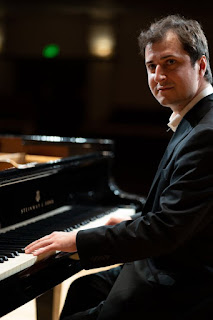Kenny Broberg plays a UIndy recital typical of his unique perspective
 |
| Kenny Broberg |
Launching this week into a return visit to the University of Indianapolis, part of Kenny Broberg 's package of engagements from his victory in the American Pianists Association's classical competition here, the pianist gave a recital in Ruth Lilly Performance Hall Tuesday night that was crowned by his performance of Nikolai Medtner's "Night Wind" Sonata.
A complex piece with five connected movements, unconventionally laid out, this presentation could have used some program notes, either printed or delivered from the stage. But the music itself was able to make an impact on its own, and perhaps Broberg is among the artists who feel any sort of verbal detail about a piece deprives it of some of its power, especially when it is unfamiliar to an audience.
A Russian composer of German extraction, Medtner distinguished himself as a pianist from his student days at the Moscow Coservatory. Like his slightly older, more esteemed countryman Sergei Rachmaninoff, Medtner will always have the hyphenated reputation of pianist-composer. Forced into exile by the Russian Revolution, he died in London in 1951. Like Rachamaninoff, he was unsympathetic to modernism; unlike him he hardly put compositional pen to paper unless it was to write for the piano.
Broberg has shown a deep-dyed affinity with Russian music — Scriabin and Medtner in particular — since first becoming known here as a candidate for APA's Christel DeHaan Fellowship a couple of years ago, winning the award as the pandemic receded. Of a recital program in June 2021, I wrote of Broberg's performance of another Medtner sonata (op. 30 in A minor): "The melancholy behind the relentless energy of the mature Rachmaninoff is adumbrated here, and the recitalist projected a sure sense of it."
The "Night Wind" Sonata is dedicated to Rachmaninoff, and bears an advisory subtitle: "the whole piece in epic spirit." Broberg called up and sustained that spirit in the half-hour-plus expanse of the work. He showed consistency in building a pattern of phrases, often in crescendo, over lengthy arcs. The sonata's formal integrity could be discerned in part because of Broberg's mastery of the long view, which knitted disparate episodes together. Epics do that kind of thing characteristically, as literature illustrates from "Odyssey" to "Paradise Lost."
The pianist's transition into the second Allegro was imbued with an air of mystery. That gift has been evident in Broberg's interpretation of Scriabin, the ultimate in mystery among Russian composers. Broberg's elucidation of the contrapuntal texture that enters in the second fast movement was well-defined. Some of the classical manner of Brahms' variation style was evident in the approach to the Quasi cadenza finale, as it had been in the recital's opening piece. That was the pianist Harold Bauer's reworking of Cesar Franck's "Prelude, Fugue et Variation," an organ work whose final section also represents Franck's salute to the classicism of Camille Saint-Saens.
Among the displays of Broberg's patrician legato feeling for melody was the first part of Ballade in D-flat major, op. 6, by the prolific Amy Beach, an American composer who was admired in her own time (starting in the late 19th century) and has reached renewed popularity in the current quest to diversify the repertoire. The work quickens and thickens — a development to which Broberg sounded fully responsive — before subsiding to a quietly effective conclusion.
The only piece representing the mainstream of piano repertoire was Beethoven's Sonata No. 26 in D-flat major, op. 81a ("Les Adieux"). A rare example of program music among Beethoven's writing for piano, the sonata requires direct engagement with its "farewell" motif and a willingness not to wrench any extra pathos out of the progress of saying goodbye to a friend, missing that friend, and rejoicing in the reunion. That covers the sonata's three movements, and this performance's no-nonsense approach worked perfectly. Yet Broberg made the most of the billowing phrases in the middle movement, and built up suspensefully to the effusive finale. Again, his dynamic control was arresting and well-designed, with mastery over the entire spectrum of piano volume, from whispering to torrential.
[Photo by Lee Clifford]



Comments
Post a Comment